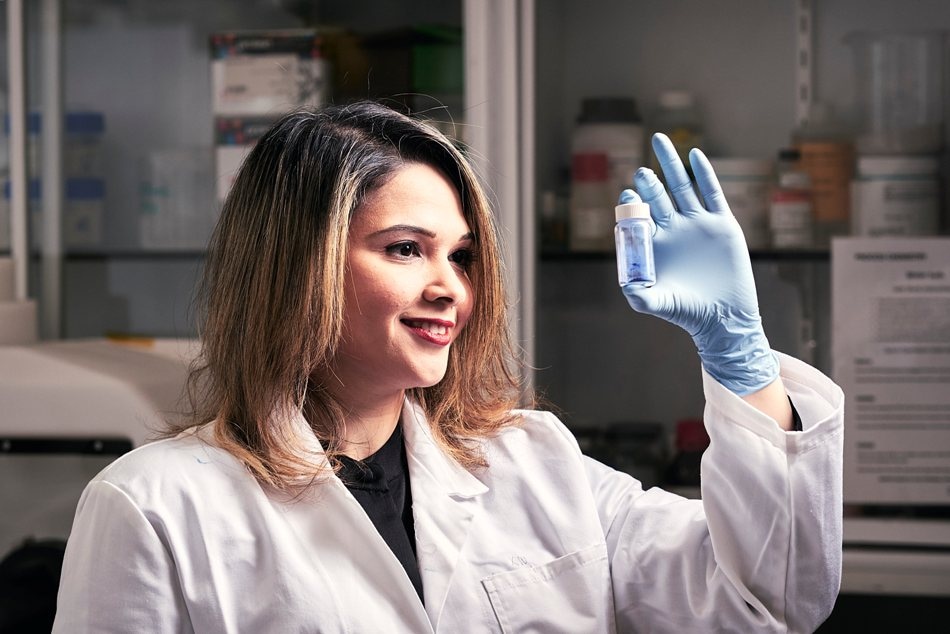May 24 2019
Scientists have identified a new way to speed up the sustainable development of groundbreaking smart materials—using sound waves to accurately control molecules and atoms.
 Dr Heba Ahmed holding a MOF created with high-frequency sound waves. (Image credit: RMIT University)
Dr Heba Ahmed holding a MOF created with high-frequency sound waves. (Image credit: RMIT University)
Metal-organic frameworks (MOFs) are super porous and extremely versatile nanomaterials that can be used for storing, separating, releasing, or protecting nearly anything.
MOF is predicted to be a groundbreaking material of the 21st century and is perfect for sensing and capturing substances at trace concentrations, to cleanse air or water, and this material can also hold large amounts of energy, for producing better energy storage devices and batteries.
Researchers have created over 88,000 precisely-customized MOFs, with applications ranging from pharmaceuticals to agriculture; however, the standard process used for producing the MOFs is not environmentally sustainable and can involve several hours to days.
Scientists from RMIT University have now developed a clean, green method that can create a customized MOF within the span of minutes.
According to Dr Heba Ahmed, lead author of the study featured in Nature Communications, the scaleable and efficient technique harnessed the super power of high-frequency sound waves.
MOFs have boundless potential, but we need cleaner and faster synthesis techniques to take full advantage of all their possible benefits. Our acoustically-driven approach avoids the environmental harms of traditional methods and produces ready-to-use MOFs quickly and sustainably. The technique not only eliminates one of the most time-consuming steps in making MOFs, it leaves no trace and can be easily scaled up for efficient mass production.
Dr Heba Ahmed, Study Lead Author and Postdoctoral Researcher, Micro/Nanophysics Research Laboratory, RMIT University
Sound device: how to make a MOF
MOFs are crystalline powders that contain small, molecular-sized holes in abundant amounts. They possess a special structure—metals connected to one another through organic linkers—and are also extremely porous; for example, if individuals were to take a gram of MOF and spread out its internal surface area, they would cover a space larger than the size of a football pitch.
It has been predicted by some researchers that MOFs could be as significant to the 21st century as plastics were to the 20th era.
During the usual production procedure, solvents and other kinds of contaminants get trapped in the MOF’s holes. In order to remove them, researchers generally apply a combination of high temperatures and vacuum or harmful chemical solvents in a process known as “activation.” In their latest method, the researchers from RMIT University utilized a microchip to create high-frequency sound waves.
According to Dr Amgad Rezk, co-author and acoustic expert, these sound waves cannot be heard by humans and can be utilized for precision nano- and micro-manufacturing.
“At the nano-scale, sound waves are powerful tools for the meticulous ordering and manoeuvring of atoms and molecules,” stated Rezk.
The MOF’s “ingredients”—a binding organic molecule and a metal precursor—were subjected to sound waves produced by the microchip. The researchers used the sound waves to assemble and join these elements together and successfully produced a porous and highly ordered network, while concurrently “activating” the MOF by flushing out the solvents and other contaminants from the holes.
According to Leslie Yeo, lead investigator and Distinguished Professor of Chemical Engineering, the novel technique creates MOFs with a high surface area and vacant holes, thus removing the necessity for post-synthesis “activation”.
Existing techniques usually take a long time from synthesis to activation but our approach not only produces MOFs within a few minutes, they are already activated and ready for direct application.
Leslie Yeo, Director, Micro/Nanophysics Research Laboratory, RMIT University
The scientists effectively tested their technique on iron- and copper-based MOFs, but the method can also be extended to other kinds of MOFs and scaled out for producing these unique materials in an efficient and green way.
The study titled, “Acoustomicrofluidic assembly of oriented and simultaneously-activated metal-organic frameworks” has been published in Nature Communications. Collaborators included CSIRO and the ARC Centre of Excellence in Convergent Bio-Nano Science and Technology at the University of Melbourne.